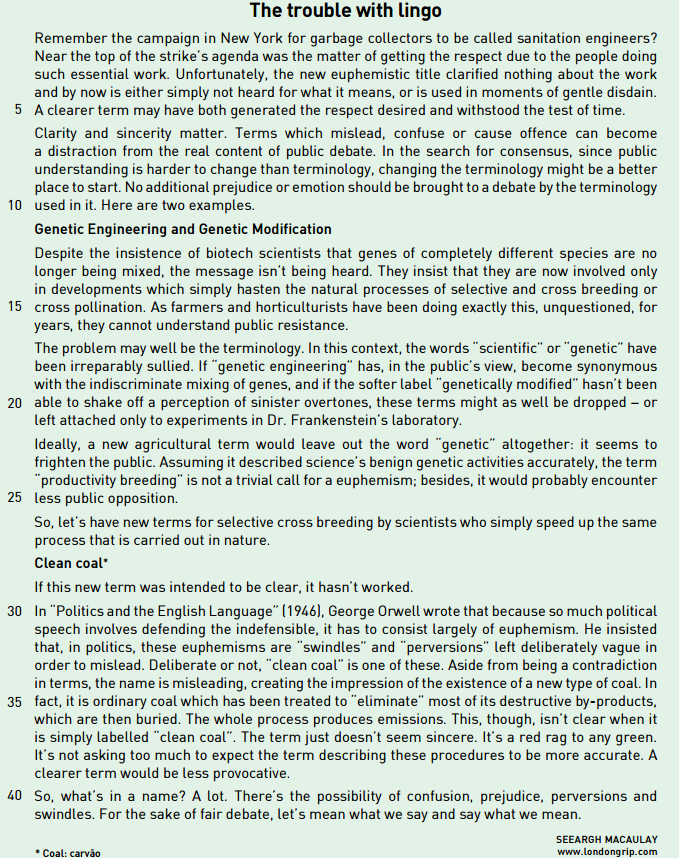In the excerpt from the second paragraph “and polishes it to
the point of incomprehension”, the underlined word refers to




NOGUEIRA, Salvador. Translated by Marina Della Valle. Disponível em: <
www1folha.uol.com.br/internacional/em/scienceandhealth/2016/03/
1755511-russia-will-install-telescope-in-brazil..shtml>. Acesso em: 27 set.
2016.
Beyonce, colorism, and why all of this needs to end
by Ernest Owens
Yes, the Super Bowl was on fire. As one who is very critical of halftime show performances, I cannot deny that Beyoncé brought the energy and attention. All of this led to her releasing her tour dates for the Mrs. Carter Show. As excited as I was to actually buy these tickets, something turned me off. The poster.

If you haven’t seen the photographs for Beyonce’s new world tour, you probably wouldn’t even recognize her. You will see an image of what looks like a Victorian white woman in the Elizabethan era. Her (prosthetic) blonde hair puffed and extended to reveal a face that is almost as white as snow. Lips red and her skin powdered. This is not the same bronze Beyonce that I saw rocking the stage in an all female band with her darker Destiny’s Child counterparts. I was only left with memories of previous patterns that the multi-Grammy award winning artist had done in previous years in regards to her skin. And I asked myself the question: why, Bey?
Let’s not act like this is something new. Over the years, it seems as though Beyonce has gotten lighter as she has gotten older. No, this is not genetics and let’s not pretend her skin color in her first Destiny’s Child album cover matches that of her latest album. Whether it is that highly controversial Revlon advertisement or her own album cover art, Beyonce has consistently been called out on alterations done to her pigments.
What does this say about our society for black women? It tells me that, an independent, confident and successful woman of color still struggles to have the confidence to fully embrace the skin she is in. If one of the most powerful women in entertainment feels she has to lighten her skin for projection, what does that say for the rest of us?
Believe it or not, colorism, the stigma associated with skin complexion, has been an ill that has not yet been dissolved by the black community. What was first given to us by slave masters in separating the house slaves from the field ones, has now taken place in how we objectify our women and each other.
This is pretty problematic in many ways. It’s first of all self-loathing and unnecessary for today’s times. The fact that our nation had an African-American first lady with a complexion that isn’t on the lighter side of the spectrum, nor does it try to be, shows a compelling advancement in appreciation for all women of color in many ways.
Furthermore, the only reason why such stigma in our country continues is contributed to our own behavior that is shaped by the influential people of color around us. It devastated me when I saw that Sammy Sosa had lightened his skin. As successful as he was in a field that was not necessarily fixated on male skin complexion, it saddened me to see him do it. In many ways, it even made me reflect back on the transition of the late great Michael Jackson and what explanations he had for such a more pale white appearance.
And why does all of this matter? Because I grew up hearing stories of young dark black girls getting their faces scrubbed with skin lightening soaps out of their free will. Tales of young women being abandoned by their mothers because they were too dark.
If this is the reality that had more implications back in the early 20th century than it does now, please stop it. Stop trying to explain why you are dating the ebony skin girl. Stop making it seem exceptional that a girl of a darker complexion is actually attractive. Celebrities, stop putting extraneous powders and lighteners on your skin: we all know what you used to look like and we still love you. And people of color: let’s not continue to perpetuate an oppressive cycle of self-loathing of our appearance and heritage. If this can be accomplished, then perhaps even in our own race we can truly make our lives not be judged by the color of our skin but by the content of our character.
(adapted from www.huffingtonpost.com, 14/02/2013)



Text
The School of the Future


Disponível em: https://www.typekids.com/blog/the-school-of-the-future/ Texto adaptado. Acesso em: 30 ago. 2020.

The true potential of technology to change behavior
Technology could successfully change behaviours where decades of campaigns and legislation have failed. With the quantified self already walking among us and the internet of things within easy reach, digital technology is creating unprecedented opportunities to encourage, enable and empower more sustainable behaviours.
If we are to unlock the power of technology we must be more ambitious than simply digitising analogue strategies or creating another communications channel.
The true potential of technology lies in its ability to do things that nothing else can do. In behaviour change terms, the potential to succeed where decades of education programmes, awareness campaigns and product innovation have failed; to make a difference where government policy and legislation has had limited impact.
Using behavioural insights, it is possible to highlight the bottlenecks, drop out points and achilles heels of traditional behaviour change efforts — the reasons why we have failed in the past — and apply the unique possibilities of technology to these specific challenges.
Overcoming our limitations
Luckily, the history of the human race is almost defined by its ability to invent stuff that bolsters its feeble capabilities. That stuff is, of course, what we generically refer to as 'technology'. And in the same way that the internal combustion engine and the light bulb allow us to overcome our relatively feeble powers of motion and perception, so digital technology can be directed to overcoming our relatively feeble powers of reasoning, selfcontrol, motivation, self-awareness and agency—the factors that make behaviour change so difficult.
Herein lies the true potential of technology: not in the laboratory or the workshop, but in an understanding of the behavioural dynamics that define the human condition, both generally and within the context of a specific user-group, market segment or community.
Fonte: JOHNSON, Steven. Recognising the true potential of technology to change behaviour. Disponível em:<https://www.theguardian.com/sustainablebusiness/behavioural-insights/true-potential-technology-change-behaviour>


MIRCHANDANI, Rajesh. Polar bears will be protected in Alaska. Disponível em:<<www.bbc.co.uk/worldservice/learningenglish/language/wordsinthenews/2010/11/100929_with_polarbears_page.shtml>. Acesso em: 2 dez. 2010.
In the excerpts we can also have conversations and what should parents look for, two modal
verbs are used, can as possibility and should as advisability.


The author states that the process of eliminating the destructive by-products of the so-called “clean coal” produces emissions.
The fragment of the text in which the underlined pronoun refers to the statement above is:

it has to consist largely of euphemism. (l. 31)
“clean coal” is one of these. (l. 33)
ordinary coal which has been treated to “eliminate” most of its destructive by-products, (l. 35)
This, though, isn’t clear (l.36)

Alice Munro’s road to Nobel literature prize was not easy

Nobel literature prize winner Alice Munro.
Alice Munro has been awarded the 2013 Nobel Prize in literature, thus becoming its 13th female recipient. It’s a thrilling honour for a major writer: Munro has long been recognised in North America and the UK, but the Nobel will draw international attention, not only to women’s writing and Canadian writing, but to the short story, Munro’s chosen literary genre and one often neglected.
The road to the Nobel wasn’t an easy one for Munro. She found herself referred to as “some housewife”, and was told that her subject matter, being too “domestic”, was boring. A male writer told her she wrote good stories, but he wouldn’t want to sleep with her. “Nobody invited him,” said Munro. Maybe as a consequence of this initial reaction towards her, when writers occur in Munro stories, they are pretentious, or exploitative of others; or they’re being asked by their relatives why they aren’t famous, or – worse, if female – why they aren’t better-looking.
The chances that a literary star would emerge from her time and place would once have been zero. Munro was born in 1931, and thus experienced the Depression as a child and the Second World War as a teenager. This was in south-western Ontario, Canada, a region that also produced equally talented writers and poets such as Robertson Davies, Graeme Gibson, James Reaney, and Marian Engel. It’s this small-town setting that features most often in her stories – the snobberies, the eccentrics, and the jeering at ambitions, especially artistic ones.
Shame is a common driving force for Munro’s characters just as perfectionism in the writing and courage in her profession have been driving forces for her.
As in much else, Munro is essentially Canadian. Faced with the Nobel, she will be modest, she won’t get a swelled head. The rest of us, on this magnificent occasion, will just have to do that for her.



